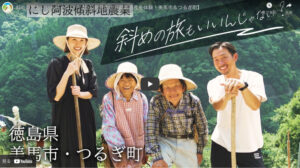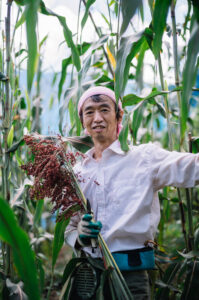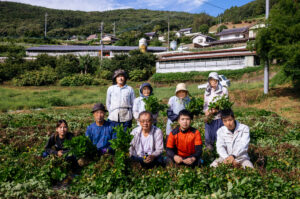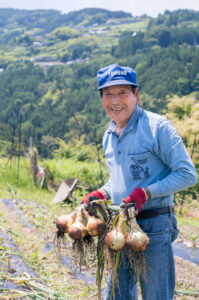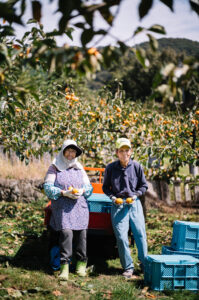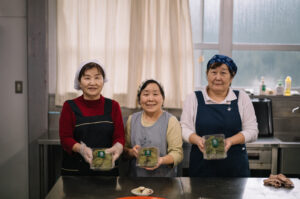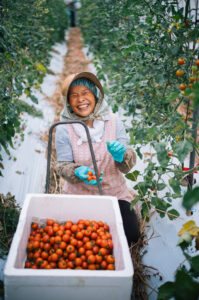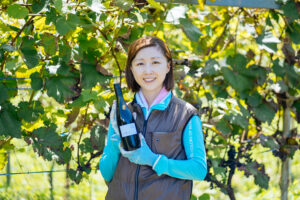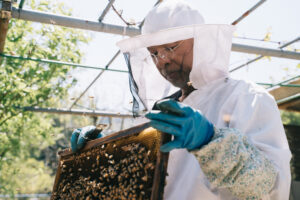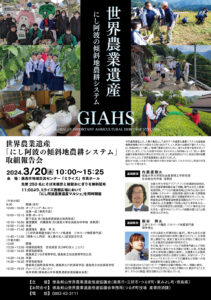Yasunori Nakajima | The People Supporting Globally Important Agricultural Heritage System
Yasunori Nakajima(Tsurugi town, cultivating Takakibi (sorghum)) A blue net stretches across a steep mountainside, serving as a protective barrier against Takakibi (sorghum) nuts from birds. In 2015, Yasunori Nakajima relocated from the Kanagawa Prefecture to Tsurugi town, where his grandmother lives, to practice farming. His farm is located at an altitude of approximately 600 m above sea level. The mountain slopes are well-drained, and significant temperature difference facilitates vegetable and millet cultivation. Every year, he grows Takakibi (sorghum) in his field. Takakibi seeds are sown in late April with the seedlings developing for approximately a month. Once the seedlings attain a height of 15–20 cm, they are transplanted to the […]
Minori-no-Mori Indigo producer’s association | The People Supporting Globally Important Agricultural Heritage System
Minori-no-Mori Indigo producer’s association(Mima city, indigo cultivation) Kirikubo village is located in Mima town, Mima city. In summer, fields on the slopes are covered with bright green leaves. These fields are planted with Tade-ai, whose leaves are used for indigo dyeing. Notably, the indigo cultivated here also serves as a food source. The Awa domain has promoted indigo cultivation in the Yoshino River basin since the Azuchi-Momoyama period. From the mid-Edo period until the late Meiji period, indigo cultivation flourished due to increased demand. However, indigo cultivation declined following the importation of cheaper indigo from India. In recent years, scientific research revealed that indigo contains antioxidants (indigo polyphenols and flavonoids) […]
Akira Kondo | The People Supporting Globally Important Agricultural Heritage System
Akira Kondo(Higashi-Miyoshi Town, Ichigo House Farm Inn) Higashi-Miyoshi is a rare region of Japan where strawberries can be harvested year-round in greenhouses in the mountains and plains. In addition to strawberries, Akira Kondo grows onions in the mountain fields where his home is located. He stated that a well-drained field on a slope produces good-quality onions. In the fields, kaya is used as a fertilizer. Additionally, in the plain area of Miyoshi City, he owns a greenhouse for growing strawberries, where he also offers the strawberry-picking experience to customers. His son, Masashi, serves konjac made from homemade Konjac bulbs to customers. Thinly sliced Konjac is relished with yuzu ponzu (citrus […]
Kikue Nagae | The People Supporting Globally Important Agricultural Heritage System
Kikue Nagae(Farmer in Mima city) Mrs. Nagae cultivates persimmons on the slopes of the Asan Mountains, situated on the northern bank of the Yoshino River. Previously, she cultivated Hassaku oranges. However, after the trees perished during a particularly severe winter, she transitioned to persimmon cultivation in 1988. She cultivates seven varieties of persimmons, including Tonegaki, Hiratanegaki, and Yamatogaki. The harvest season is from mid-September to late November. The harvested persimmons are sold at local roadside stations or sent to suppliers outside the prefecture for processing into Japanese sweets and other products. Additionally, she sells seasonal vegetables at roadside stations. “Cultivation, pruning, and harvesting of persimmons is labor-intensive,” she said, “but […]
Tsurugi Life Improvement Promotion Council Ichiu group | The People Supporting Globally Important Agricultural Heritage System
Tsurugi Life Improvement Promotion Council Ichiu group(Tsurugi Town) “Sadanojo dango” is filled with mugwort and mashed sweet bean paste. This popular delicacy is produced by the Tsurugi Life Improvement Promotion Council Ichiu group. The term “Sadanojo” derives from Tani Sadanojo, a village headman of Ichiu who was executed for directly appealing to the villagers for help during the Edo period. The mugwort used for dango is harvested annually by group members in mid-April from the mountains of the Ichiu area. Thereafter, it is preserved through freezing and used for dango production from spring to fall. These dango are sold at the Shakunage Market, which operates exclusively on Sundays from March […]
Yoko Ando | The People Supporting Globally Important Agricultural Heritage System
Yoko Ando (Higashi-Miyoshi town / farmer, Anchan-chi guest house ) The Anchan-chi guest house is located in Kamoyama, Higashi-Miyoshi town. It is acquiring popularity in Nishi-Awa as a hotel where visitors can experience indigenous agriculture. Yoko Ando, a farmer, runs this hotel. In summer, tomatoes and melons are grown in greenhouses. In winter, she gets busy processing dried potatoes. Regarding the processing of dried potatoes, first, sweet potatoes harvested in the fall are stored in a specially built shed until January, when the sweetness increases. Thereafter, the sweet potatoes that became sweet enough are cooked over wood. She cherishes local traditional events and holds a biannual event called “Zuzukuri” in […]
Namika Inoshita | The People Supporting Globally Important Agricultural Heritage System
Namika Inoshita (Natan Winery in Miyoshi City) Since 2016, wine grapes have been cultivated on the slopes of the Asan Mountains, which run along the northern bank of the Yoshino River. Namika Inoshita, the pioneering founder of Tokushima's first winery, grows grapes for wine production. She leases fallow land and cultivates over 10 grape varieties across six fields in Miyoshi City, including Pinot Noir and Yama Sauvignon. Namika uses sustainable practices to maximize the grapes’ natural potential. For example, instead of using chemical fertilizers, she mows the grass in the vineyards and uses it as compost. The mountainous region of Miyoshi is ideal for grape cultivation because of its abundant […]
Yoshimasa Uchida | The People Supporting Globally Important Agricultural Heritage System
Yoshimasa Uchida(Miyoshi City/asobimotte) Asobimotte is a brand of honey reflecting the concept of "playing while working" (遊びもって= asobimotte). The name indicates that the honey is produced through collaboration among friends who enjoy their work. Yoshimasa Uchida keeps bees in Shinyama, Ikeda Town, Miyoshi City. In one corner of the field, rows of beehives house both Western honeybees and Japanese honeybees. The Japanese honeybee is particularly delicate and challenging to raise, and it produces only a small amount of honey. These bees collect nectar from a variety of flowers, giving their honey a rich yet mellow sweetness that truly embodies the flavors of the region’s lush natural environment. Originally, the honey […]
Nishi-Awa GIAHS Progress Meeting on March 20, 2024
The Nishi-Awa Steep Slope Land Agriculture System was designated as a Globally Important Agricultural Heritage System (GIAHS) six years ago. We are to reflect on the initiatives and changes that have taken place thus far and consider what we should do to empower Nishi-Awa. Title: Nishi-Awa GIAHS Progress Meeting Date: March 20, 2024 10:00~15:25 Venue: Mima City Community Centre, Miraizu Participation fee: Free Free distribution of soba rice porridge and mixed-millet rice balls to the first 250 persons. Starting at 11:00am, the 'Nishi-Awa GIAHS Market' will be held simultaneously at the Mirai's West Plaza. 【Contact】Tokushima Tsurugisan Global Agricultural Heritage Promotion Council Secretariat. Program <morning session> 10:00 Opening remark 10:10 Keynote speech by […]


